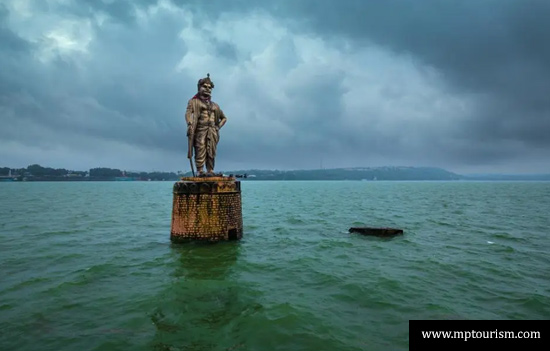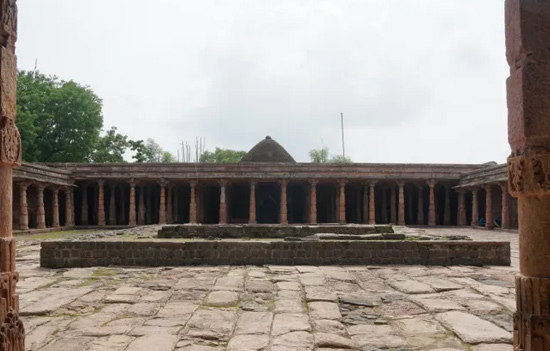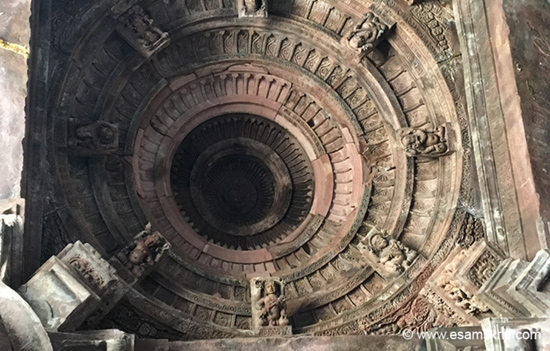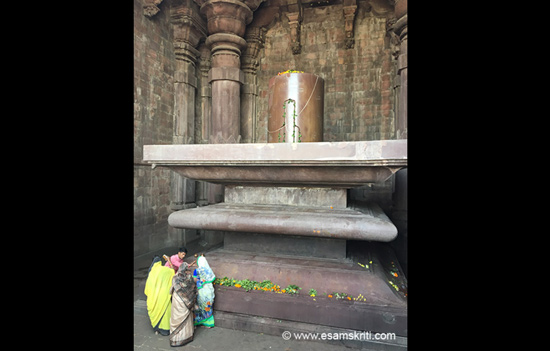Raja Bhoj wrote 84 books on a wide variety of subjects. He was also a righteous ruler, built lakes and temples.
Great men and women are a product of time, place, and
circumstance. The exceptional demands of the situation in which they are thrust
brings out the abilities that sets them apart. Yet there are individuals who
rise so much above what their predecessors have done that they become world
figures.
Examples of unparalleled leaders in the military sphere
include the Carthaginian general Hannibal, Alexander of Macedonia, Julius
Caesar, Genghis Khan, and Napoleon Bonaparte. Of these, Julius Caesar was also
an author and I have admired his direct style in the memoir The
Commentarii de Bello Gallico, known in English as The Gallic Wars.
I believe there is no ruler in world history who equals
the intellectual achievements of Bhoja-deva Paramāra भोजदेव परमार सम्राट (r. 1010–1055), (Bhoja-rāja भोजराज), who ruled a
vast empire from his capital at Dhār (Dhārānagarī).
He was not only a military leader who defeated many kings, he was a person of acute intellect, a polymath, who wrote 84 books on subjects that include chemistry, grammar, architecture, hydraulics, music, poetics, astronomy, medicine, city planning, and robotics.
At its broadest, Bhoja’s empire is believed to have stretched from Vidisha in the East to Sabarmati River the west and from Chittor in the North to Konkan in the South, that is most of middle India, although the Udaipur Prashasti claims that his rule covered most of India. His armies also went to fight in Sindh and Afghanistan.
Known popularly as Rājā Bhoja, his rule may have started somewhat before 1010. The earliest known reference to him is from the copper plates found at Modasa in North Gujarat dated to 1010 CE. A contemporary account of his rule is in Dhanapāla’s Tilaka-Mañjari (11th century). Merutuṅga’s Prabandha-cintāmaṇi completed in the fourteenth century, states that he ruled for 55 years, 7 months and 3 days, indicating that his rule may have spanned 1000–1055. Another important source is Ballāla’s Bhoja-prabandha composed at Varanasi in the 17th century.
 Bhopal Lake.
Bhopal Lake.
He was a contemporary of the great Chola emperor Rājendra I (r. 1014- 1044), who conquered Sri Lanka and large parts of Southeast Asia. The two, Bhoja and Rajendra Chola, formed a confederacy to conquer East India and thus, together, they dominated most of India. According to one inscription, the confederacy also included the Kalacuri king Gangeyadeva. Perhaps the statement of Bhoja’s rule covering most of India in the Udaipur Prashasti is to indicate the extent of the empires of the two allies. The confederacy-empire was the largest in India’s history.
Bhoja founded the
city of Bhojpur. The name Bhojpuri for the language widely
spoken in India, Fiji, and the Caribbean is from this city that lent its name
to a state.
According to
Bhoja-Prabandha, Bhoja as a youth suffered from intense headaches. Two surgeons
from Ujjain operated on his brain to remove a tumor that cured him.
For centuries he
was remembered as the most famous king of India. The story of his Dhār is in
this dance drama. Here are two documentaries on him:
एक अपराजित विजेता: राजा भोज का इतिहास
परमार राजा भोज और भोपाल शहर
Bhoja was revered as the ideal and perfect king, and many who followed him such as king Arjunavarman (c 1210–15) were taken to be his reincarnation. The great Krishnadevarāya of the Vijayanagara Empire styled himself as Abhinava-Bhoja (“the new Bhoja”) and Sakala-Kalā-Bhoja (“Bhoja of all the arts”).
Military campaigns
Bhoja’s military campaigns and conquests were in all directions. We have inscriptional evidence of his campaign in Gujarat in 1018 and in Konkana in 1020. His military alliance with Rājendra Chola and Gangeyadeva Kalachuri took place in 1019. As allies, they defeated Indranātha, the Somavamshi king of Kalinga.
The Udaipur Prashasti claims that Bhoja’s armies defeated the Turks. Bhoja is believed to have sent troops to the Kabul Shahi ruler Ᾱnandapāla’s in his fight against the Ghaznavids, and he granted asylum to Ᾱnandapāla’s son Trilochanapāla.
Medieval Muslim historians state that Mahmud of Ghazni avoided a confrontation with a powerful Hindu ruler named Param Dev after sacking the Somnath temple. Modern historians identify Param Dev as Bhoja Paramāra-Deva. He was likely part of the alliance that expelled Mahmud’s governors from Hansi, Thanesar and other areas around 1043.
Bhoja’s books
Bhoja wrote 84
books. These include the following Sanskrit-language texts.
Astronomy and
astrology:
Vidvajjana-Vallabha,
treatise on astronomy
Bhujabalabhīma, a
work on astrology
Chemistry:
Rāja-mṛgāṅka-karaṇa,
a treatise on chemistry, especially dealing with the extraction of metals from
ores, and production of various drugs.
Literature:
Campūrāmāyaṇa, a
re-telling of the Ramayana in mixture of prose and poetry, which characterises
the campu genre.
Govinda-vilāsa,
poem
Śṛṅgāramañjarīkathā, a poem
The Prakrit
language poems Kodanḍa-Kāvya and Kūrma-Śataka.
Philosophy:
Rājamārtanḍa or Patañjali-Yogasūtra-Bhāṣya, a major commentary on the Yoga Sutras of Patanjali.
Tattvaprākaśa, a
treatise on Śaivite philosophy that is also a synthesis of certain tantras.
Architecture,
iconography, machines:
Samarāṇgaṇa-sūtradhāra,
समराङ्गणसूत्रधार.
a treatise on architecture, iconography, and mechanical machines and
Vāstuśāstra and Śilpaśāstra. Its 83 chapters describe construction of
buildings, forts, temples, images of deities and mechanical devices including a
flying machine. Twenty chapters are devoted to temples and their
classification, fourteen to images and iconography, and six to canons of
painting.
I’ll have more on this in a later section.
Poetics and
grammar:
Sarasvatīkaṇṭhabharaṇa, or “Necklace of Sarasvatī”, is a treatise on Sanskrit grammar that includes a discussion of Vedic forms Nāma-Mālikā, a treatise on lexicography
Śṛṅgāraprakāśa,
treatise on poetics and dramaturgy. Unlike the dhvani theory
of Anandavardhana and Abhinavagupta, Bhoja sees śṛṅgāra, beauty
and cleverness, as the fundamental and motivating impulse in the
universe and this view may have influenced the Kashmiri scholar Mammaṭa.
Medicine:
Ᾱyurveda-Sarvasva
Śālihotra, a book
on horses, their diseases and the remedies
Cārucārya, a
treatise on personal health and well-being.
Dharmaśāstra:
Kṛtyasamuccya
Bhujabula
Vyavahāramañjarī.
Encyclopedic:
Yukti-Kalpataru, a
work on several topics including statecraft, politics, city-building,
jewel-testing, characteristics of books, and ship-building.
Subhāṣita-Prabandha
Music:
Saṅgītarāja,
attributed to Kumbha, names Bhoja as an authority on music, which suggests that
he also wrote a work on it.
Bhoja on machines and aircraft:
The thirty-first chapter of Samarāṇgaṇa-sūtradhāra is called Yantra-Vijñāna (Science of Self-operating Machines). These yantras include mechanical toys or robots.
There is also a
description of a flying machine:
लघुदारुमयं महाविहंगं
दृढसुश्लिष्टतनुं
विधाय
तस्य
उदरे रसयन्त्रमादधीत
ज्वलनाधारमधोऽस्य
चातिपूर्णम्॥
९५
तत्रारूढ: पूरुषस्तस्य
पक्षद्वन्द्वोच्चालप्रोज्झितेनानिलेन
सुप्तस्वान्त: पारदस्यास्य
शक्त्या
चित्रं
कुर्वन्नम्बरे
याति
दूरम्॥
९६
laghudārumayam
mahāvihaṅgaṃ dṛḍhasuśliṣṭatanuṃ vidhāya tasya
udare rasayantramādadhīta jvalanādhāramadho’ sya cāti pūrṇam
tatrārūḍha
puruṣastasya pakṣadvandvoccālaprojjhitena anilena suptasvāntaḥ pāradasyāsya
śaktyā citraṃ kurvannambare yāti dūram
Build a great bird
of light wood, with tight sheath, in its place a rasa-yantram as receptacle for
fire.
The power of mercury and force of air from the wings in unison, a man atop may travel far through the sky, painting pictures [in the clouds] & with mind serene. SS 31.95–96
It is possible
that Bhoja made models of wooden aircraft and saw the need for an engine with
fire to obtain forward motion by pushing back air. Even if he came up with the
description based on theory alone and no models were built, it remains a
remarkable description.
Hydraulics:
The same chapter
also has a section on hydraulics:
The flow and water
pressure of water can be converted into motion. The water flow moves the
machine with effect that increases with height, pressure, and speed.
If water is
conserved, it can be used again effectively. It is the way that water flow can
be converted into power.
As a builder
 Bhojshala, Dhar.
Bhojshala, Dhar.
Merutuṅga, in his
Prabandha-Cintāmaṇi, states that Bhoja constructed 104 temples in his capital
city of Dhārā alone. Of these, the Bhojeśvara temple in Bhojpur, about 30 kms
from Bhopal, appears to be the only one that has survived.
 Dome of Bhojesvara Temple near Bhopal. Pic by Shefali Vaidya.
Dome of Bhojesvara Temple near Bhopal. Pic by Shefali Vaidya.
The Bhojeśvara
temple was never completed. Dedicated to Shiva, its lingam is 7.5 feet tall and
17.8 feet in circumference, which is set on a square platform with side of 21.5
feet. The total height of the lingam, including the platform is over 40 feet.
Detailed architecture plans for the temple are engraved on the rocks in the
surrounding quarries that indicate that the original intention was to build a
massive temple complex with many more temples. Had these plans been executed,
this would have constituted one of the largest temple complexes in India.
 Linga Bhojesvara Temple. Pic by Shefali Vaidya.
Linga Bhojesvara Temple. Pic by Shefali Vaidya.
This great temple
features several peculiar elements, including the omission of a mandapa
connected to the garbhagṛha, and the rectilinear roof instead of
the typical curvilinear shikhara. It has been proposed that the temple was a
funerary temple or a svargārohana-prāsāda.
Its great size may have been inspired by the scale of the Bṛhadīśvara temple in Thanjavur that was built by his ally Rājendra Chola’s father Rājārāja I between 1003 and 1010. The Bṛhadīśvara temple, which is 208 feet tall, was the tallest free-standing building in the world until the nineteenth century.
Bhoja, together
with the Solanki king Bhimdev of Gujarat (Anhilwara), rebuilt the temple at
Somnath between 1026 and 1042 after it was sacked by Mahmud
of Ghazni in 1024. But as we know, this temple was destroyed later.
Another notable
construction, which is a civil engineering masterpiece, is the Bhoj lake, which
was built by damming and channelizing the Betwa river, and on its bank stood
the Bhojeshwar Temple.
The Bhoj lake, 18.5
miles long and 7.5 miles wide, was constructed using three now-breached dams.
First he built a 98
foot high dam over the Betwa river; its thickness at
the base is over 300 feet which reduces to about 164 feet at the top. The earth
filled dam was encased by stone slabs of average thickness of 30 feet. Two and
a half miles north of Bhojpur near the village Mendua a second wall over a half
mile long was raised in a natural gap between two hills. The third wall, which
changed the course of the Kaliasot river, was about eighteen miles from
Bhojpur. This man-made lake existed until 15th century, when
Hoshang Shah emptied the lake by breaching two of the dams.
He also built a
tank Bhojapāla भोजपाल
(an oblong tank, पाल)
and the city that arose near it became Bhopal.
The Shiva temple
ascribed to Bhoja in the Chittor fort has an image which was named
Bhojasvāmindeva.
In his capital
city of Dhār or Dhārānagarī, he presided over a great Sanskrit college called
Sarasvatī sadana or Bhāratībhavana. Today, this place is popularly called
Bhojshala.
When Bhoja was alive,
it was said:
अद्य धारा सदाधारा सदालम्बा
सरस्वती।
पण्डिता मण्डिताः
सर्वे
भोजराजे
भुवि
स्थिते॥
Now that Raja
Bhoja is on earth, Dhārā is well grounded, Goddess Sarasvatī is well supported,
and all scholars are venerated.
 Fort wall built by Parmar rulers at Omkareshwar.
Fort wall built by Parmar rulers at Omkareshwar.
References
1. Kirit
Mankodi, Scholar-Emperor and a Funerary Temple: Eleventh Century Bhojpur.
Marg. National Centre for the Performing Arts. 39 (1987)
2. K.K.
Chakravarty, Bhojpur Temple: A Vision of Harmony. Archaeology and
Museums, Bhopal (1991);
3. Adam
Hardy, Drāviḍa temples in the Samarāṅgaṇasūtradhāra, South Asian
Studies.
4. Adam
Hardy, Theory and Practice of Temple Architecture in Medieval India (Bhoja’s Samaranganasutradhara and the Bhojpur Line Drawings), Dev Publishers (2015)
5. Adam Hardy, The Bhojpur Line Drawings — what we can draw from them. (2020); https://www.youtube.com/watch?v=ybitncZZEyc
6. Mahesh Singh,
Bhoja Paramāra and His Times. Bharatiya Vidya Prakashan (1984)
First published here eSamskriti has got permission from author to share.
Also see
1. Album
Bhojpur Shiv Mandir
2. Album
Omkareshwar Jyotirling for fort wall
3. Art
Gallery and Fort, Dhar
4. How Bhopal’s history was overturned
To read all articles
by author